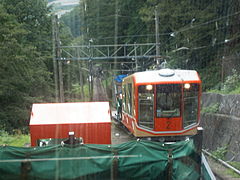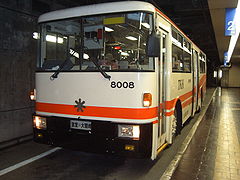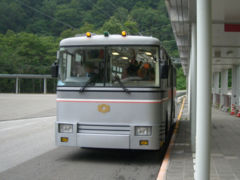This article has multiple issues. Please help improve it or discuss these issues on the talk page. (Learn how and when to remove these messages)
|



The Tateyama Kurobe Alpine Route (立山黒部アルペンルート, Tateyama Kurobe Arupen Rūto) is a mountain sightseeing route between Tateyama, Toyama and Ōmachi, Nagano, Japan. Opened on June 1, 1971, it is 37 kilometres (23 miles) long, with a difference in elevation of as much as 1,975 metres (6,480 feet).
The Alpine Route goes through Tateyama (Mt. Tate) in the Hida Mountains with many scenic sites as well as walking trails, including Japan's largest dam, Kurobe Dam. Some stations have hotels around them and are used as bases for mountain climbing or trekking. From the top of the mountain, it is possible to see Mount Fuji on a clear day.
Overview
The route is composed of seven different transportation services using five different modes: funicular, bus, trolleybus, aerial tramway, and walking. Three transport lines go through tunnels to protect them from snow: one funicular railway and two bus lines. One of the bus lines is the last trolleybus line in Japan, and the other was converted to all-electric buses in 2018. The bus lines are used because they do not exhaust fumes in the tunnels. During summer, shuttle buses between Toyama and Murodō are also available.
The Tateyama Kurobe Kankō (立山黒部貫光) operates most lines in the route. Its official abbreviation is TKK. The word kankō (貫光) was coined by Muneyoshi Saeki, the first president of the company. According to him, kan (貫) means "time-space", and kō (光) means "outer space", while kan (貫) also (normally) means "to penetrate", as in "to penetrate Tateyama Mountains" and kō (normally) means "light". The word is a homophone to kankō (観光; "sightseeing"), possibly intentionally.
Lines and stations
| Transfer station / terminus | Japanese | Elevation | Transport mode | Line name | Distance | Location | |
|---|---|---|---|---|---|---|---|
| Dentetsu-Toyama | 電鉄富山 | 7 m | Railway | Toyama Chiho Railway: Main Line, Tateyama Line | 34 km | Toyama | Toyama |
| Tateyama | 立山 | 475 m | Tateyama | ||||
| Funicular | TKK: Tateyama Cable Car | 1.3 km | |||||
| Bijodaira | 美女平 | 977 m | |||||
| Bus | TKK: Tateyama Highland Bus | 23 km | |||||
| Murodō | 室堂 | 2,450 m | |||||
| Trolleybus | TKK: Tateyama Tunnel Trolley Bus | 3.7 km | |||||
| Daikanbō | 大観峰 | 2,316 m | |||||
| Aerial tramway | TKK: Tateyama Ropeway | 1.7 km | |||||
| Kurobedaira | 黒部平 | 1,828 m | |||||
| Funicular | TKK: Kurobe Cable Car | 0.8 km | |||||
| Kurobeko | 黒部湖 | 1,455 m | |||||
| Walking | (15 minutes walk on Kurobe dam) | ||||||
| Kurobe Dam | 黒部ダム | 1,455 m | |||||
| Electric bus | Kansai Electric Power Company: Kanden Tunnel Electric Bus | 6.1 km | |||||
| Ōgisawa | 扇沢 | 1,433 m | Ōmachi | Nagano | |||
| Bus | Kawanakajima Bus, Kita Alps Kōtsū, and Matsumoto Electric Railway: Ōmachi Alpine Line Bus | 18 km | |||||
| Shinano-Ōmachi | 信濃大町 | 713 m | |||||
- : Sometimes considered as a part of the route. However, most guided tours use chartered buses for this section.
- : The line runs entirely in a tunnel.
- : The line is mostly in a tunnel and operated with trolleybuses until November 2018.
-
 Tateyama cable car
Tateyama cable car
-
 Tateyama Tunnel trolley bus
Tateyama Tunnel trolley bus
-
 Tateyama ropeway
Tateyama ropeway
-
 Kurobe cable car
Kurobe cable car
-
 Kanden Tunnel trolley bus
Kanden Tunnel trolley bus
Sights
| This section contains instructions, advice, or how-to content. Please help rewrite the content so that it is more encyclopedic or move it to Wikiversity, Wikibooks, or Wikivoyage. (June 2020) |
The Tateyama Kurobe Alpine Route involves many sights.
Located by Oyama peak is Oyama Shrine. This peak is better known but it is not the highest point of the mountain (Onanjiyama).
Located on Murodo Plateau from Murodō Station is a shopping area and onsen bath. The onsen on Tateyama is famously known for its use of sulfur spring water for the bath. There are also several hiking and walking paths that guide them through Hell's Valley (Jigokudani) and the other valleys. As with many volcanic areas in Japan of the same name, people cannot walk within the sulfur valley due to gas-related safety concerns.
From April 15 to mid-June, there are snow walls named Yukino-ōtani, which tower anywhere from 15 to 20 meters high (roughly 50 to 65 feet). They flank the road leading to Murodo Station. There are many charter services from Taipei, Incheon and Thailand during the high season to reach Murodo at this time.
From Murodo, visitors can also reach Kurobe Dam, which stands at 186 meters (610 feet), making it the tallest dam in Japan. From Murodō Station, visitors should take the Tateyama Tunnel Trolleybus (10 minutes), followed by the Tateyama Ropeway (7 minutes), and finally the Kurobe Cable Car (5 minutes). From the last stop, a 15-minute walk will take visitors to the dam.
Midagahara is a flat walking area filled with flowing plains interrupted by blue ponds. Near the bus stop that returns visitors to Bijodaira back down the mountain is a slightly hidden walking path. Midagahara is accessible from Tateyama Station via the Tateyama Cable Car (7 minutes) followed by Tateyama Kurobe Alpine Route bus (about 40 minutes) that goes in the direction of Murodō Station.
Shōmyō Falls (the tallest waterfall in Japan) is visible across the valley while traveling along the main road from Tateyama Station to the Murodo Plateau.
The section between Kurobe Dam and Ōgisawa was originally made for construction of the dam, while the section between Tateyama and Kurobeko was for tourists from the beginning.
Today, the entire route serves exclusively as a scenic sightseeing journey through the Japanese Alps, popular with tourists. Most travelers complete the route in one direction, either east to west or vice versa. It can be done in a single day or at a more relaxed pace, with an overnight stay at one of the lodges or hotels along the way.
See also
References
- "Tateyama Kurobe Alpine Route, the roof of Japan". dangerousroads. Retrieved 2 June 2020.
- "Kanden Trolleybus Ends Operations after 54 Years". nippon.com. 1 December 2018. Retrieved 2 June 2020.
- 貫光について (in Japanese). Archived from the original on 2009-05-24. Retrieved 2009-06-12.
- Danae (2023-09-10). "Tateyama Kurobe Alpine Route - what it's like to cross the Japanese Alps". Danae-explore. Retrieved 2024-10-02.
External links
| Transit in Toyama | |
|---|---|
| Shinkansen | |
| Other railways | |
| Cable cars and aerial tramways | |
| |
| Terminals | |
| Miscellaneous |
|
